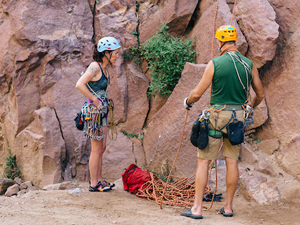Regulations
Colorado Parks & Wildlife requires that a permit be obtained prior to placing or removing any fixed rock climbing protection (bolts and pitons).
Commercial use of Colorado State Parks requires a permit. Rock climbing guides and instructors operating in Colorado State Parks must be certified or work for an accredited organization. See the American Mountain Guide Association courses for instructor training opportunities or to hire an instructor.
Safety
Rock climbing can be highly rewarding, but it also has the potential to be dangerous. Risks include, but are not limited to, falling, falling rock and other objects, equipment failure, human error, adverse weather, slippery surfaces, and negligence of other users. Colorado Parks and Wildlife does NOT maintain fixed anchors or other aspects of climbing routes. Loose rock, unreliable fixed anchors, and other hazards can exist on any route. Climb at your own risk and remember your safety is your responsibility.
To reduce your risks:
Communicate a plan before starting up a climb. There should be no confusion as to whether the climber will be lowered, rappel, or walk off.
Always have someone tied-in to each end of the rope or tie a knot in the free end of the rope. Serious falls have occurred while top-roping or lowering a climber when the free end of the rope pulled through the belay device.
Don’t rappel off the ends of your rope. Always make sure the ends are even with knots tied at  each end.
each end.
Always double-check yourself and your partner (harness buckle double-backed, tie-in knot, belay rigging and technique, and rappel set up).
Beware of loose rock. Avoid standing or climbing beneath others. Check your holds. Warn others if you dislodge rocks.
Fixed gear may be unreliable. Use fixed gear at your own risk and back it up when possible.
If climbing at a traditional climbing area, keep in mind that fundamental gear placement skills are mandatory. Never have only one piece of protection between you and a catastrophic fall.
On longer pitches or with loud ambient noise (roaring rivers, high winds, etc.) communication can be difficult. Be prepared.
On longer routes keep in mind that the sun sets sooner than you think. Allow adequate time for your climb and descent. Bring a headlamp, extra clothes, etc in case night falls before you’ve made it down.
The weather can change in an instant. Severe thunderstorms, high winds, freezing temperatures, and snowstorms can sweep in without notice. Be prepared.
A helmet can save your life.
Get professional instruction.
In case of emergency, call 911.

